

How Fast Do Catamarans Go? 5 Examples (With Pictures)
A catamaran is generally more balanced on the water and can be faster than a multi-hull vessel.
Unless you compare them to foiling monohulls like the new America’s Cup boats that sail at over 50 knots, they are not recreational vessels.
In this article, we will look at how fast each type of catamaran will go.
Table of Contents
Here are the numbers before we dive into the details:
| Sport Catamarans | 30 knots |
| Cruising Catamarans | 15 knots |
| Racing Catamarans | 45 knots |
| Power Cruising Catamarans | 70 knots |
| Swath Catamarans | 30 knots |
Average Speed For Sailing Catamarans
Catamarans can vary in size from 14 ft to over 100 ft. Catamarans can come in a wide variety of design types.
Sailing Catamarans have been attempting to make advancements over their mono-hulled counterparts.
These advancements include:
- Foils that assist with lifting the vessel out of the water.
- Stability advancements.
- Racers that can maintain their speed while out in the ocean.
3 Different Types of Sailing Catamarans:
1) sport catamarans.

One type of sailing catamaran is a sport catamaran, which is otherwise known as recreational. These are typically supposed to have a small crew and launch and land on beaches.
Sport catamarans do not normally have living quarters and are ideal for day trips. Resorts or other rental services often use these.
These can also be used for racing.
Sport vessels have been known to travel over 30 knots but can speed over 40 knots in the proper conditions.
2) Cruising Catamarans

Another type of sailing catamaran is a cruising catamaran. These often come with complete living accommodations, so they sacrifice speed over their sportier counterparts.
They can average between 9 and 10 knots, depending on the conditions. The top speed is typically around 15 knots.
It would be best if you were careful with catamarans that have living quarters. The more you weigh it down, the less speed you will have.
3) Racing Catamarans

The final type of sailing catamaran is an ocean racing catamaran.
These boats are large and can reach over 100 feet in length.
The top speed of this type of catamaran is around 45 knots.
Because of the prize money for entering these in races, much research goes into their advancement.
Average Speed Of Power Catamarans
Catamarans with power motors fill a different type of boating category.
These are commonly used when speed and smoothness are favored over space or capacity.
Because of their stability, catamarans are good vessels for combating seasickness as well as transportation. We have a separate article here with all you should know about catamarans and (how to overcome) seasickness .
On a commercial level, these can be used for ferries for both people and vehicles. They are used for short term travel, often to or from islands.
Like sailing catamarans, there are a few types of power catamarans.
1) Power Cruising Catamarans

Similar to sailing cruising catamarans, they also have power cruising catamarans. These also have living quarters and are stable while out on the water. The speed of these vessels highly depends on the motors equipped and the size of the boat itself.
Like passenger transport or ferries, catamarans have a high speed of about 40 to 70 miles per hour.
These are made to travel at great speeds to allow their commuters the shortest possible ride to their destination.
The military also utilizes power catamarans. They use power catamarans to transport military cargo. These ships are ideal because of their speed, holding capacity, and ability to venture into shallow ports.
2) Swath Catamarans

They also have small-waterplane-area twin-hull vessels. These are called SWATHs.
These differ from the average catamaran because they also have submarine-like hulls that stay completely under the water.
Due to the hulls being submerged, they are not normally affected by waves. These are used most often in the ocean as research vessels. They can also be used for certain types of yachts. Because of their stability, they are good vessels for furniture that will not require as much securing.
These often travel between 20 and 30 knots.
Some catamarans are designed for wave piercing. These are made to pierce through waves rather than sail over them, causing them to be faster. These can be used as passenger ferries, yachts, and military vessels as well.
3) Whitewater Catamarans

There are also recreational catamarans made for whitewater travel. These are sometimes called “cata-rafts.”
They are made using two inflatable hulls connected with a scaffold. These are lightweight and perfect for whitewater sports.
They are even able to be packed away in a backpack. They can take up to 20 minutes to assemble, including inflation.
They have high speeds on white water rivers and can be most compared to a canoe, kayak, whitewater raft, or other white water vessels.
Performance Characteristics Of Catamarans
Catamarans require four times the power to double their speed. A mono-hull vessel, however, would require eight times the power to double their speed.
This is because a Catamaran has less resistance in the water.
This is also good for conserving and using less energy.
Catamarans are also more stable in the water. This stability is effective at resisting heeling or capsizing. A multi-hull vessel would require four times the force to capsize as a similar-sized mono-hull vessel.
The general sailing in a catamaran is smoother and allows for activities that are not always possible on a mono-hull sailboat.
Are Catamarans Faster than Mono-Hull Vessels?
Because catamarans have less water resistance, they are generally faster than mono-hull vessels.
This is because their hulls are smaller, which means they have a smaller bow wave to fight.
A bow wave is a wave created by the displacement of water by the bow of a ship. After a certain speed, a boat has to start hauling itself over its own bow wave.
The larger hull a ship has, the larger its bow wave will be and the more power required to fight it.
Catamarans have two small and narrow hulls, so they do not have much of an issue with their bow wave. This is one reason they are usually faster than a similar-sized mono-hull vessel.
Catamarans can be between 20-30 percent faster than their monohull counterparts.
Issues with catamarans over mono-hulls are that they can take more time to turn.
How Is The Speed Measured?
Boats commonly measure speed using GPS tracking devices to measure distance traveled. Speed while sailing is measured in knots. A knot is one nautical mile per hour, which equals about 1.15 miles per hour.
How Fast Are Catamarans Compared To Other Boat Types?
- Sailing catamarans typically average about 10 knots.
- Pontoon boats average about 20 mph.
- A powerboat cruiser can average anywhere between 30 and 50 mph.
- Cigarette boats can even reach close to 90 mph in the proper conditions.
- Sailboats average between 6 and 12 mph depending on wind conditions. This includes mono-hull between 6 to 8 mph and catamarans and trimarans between 9 and 10mph
Two different factors can determine the speed of sailing ships:
1) The hull type as listed above.
Different hulls rest in the water more or less than other types. The less of the hull that is underwater, the faster it can go.
This is because the less of the hull in the water, the less drag created while sailing.
2) The length of the boat
The longer the boat, the faster it can go. Every boat has a maximum hull speed that cannot be exceeded unless the boat can plane on the water’s surface or be lifted on hydrofoils. For most boats, the longer the boat, the higher the maximum hull speed is.
Speed Vs. Comfort Considerations For Catamarans
If you are looking for a catamaran, you have a lot of options.
You can choose to prioritize speed or comfort.
After deciding to purchase a catamaran, the type of catamaran you should look at depends on where and what you are using it for.
You will want to make sure that you look at what type of water you will be traveling in, how many people you are traveling with on average, and what type of speed you hope to achieve.
One thing you will want to keep in mind before the purchase of a catamaran is storage. If you intend to store your boat in a marina, you are often charged for two slips due to the beam, or width, of a catamaran versus the standard mono-hull vessel.
Catamarans can be beneficial for those who get seasick because they offer a steadier ride and the ability to have more open air space. Because the living quarters are not inside the hull and under the water’s surface, you have more windows and visibility.
Both sailing and power catamarans are viable options. Also, sailing catamarans can come with back-up power engines for low winds or situations such as docking in a marina.
Catamarans that have twin engines can offer more control and precision than those on a mono-hull vessel. This is good for tight and busy areas or navigating marinas.
Overall, there are plenty of options for you, and they offer many benefits over their mono-hull counterparts.
Click to share...
Better Sailing
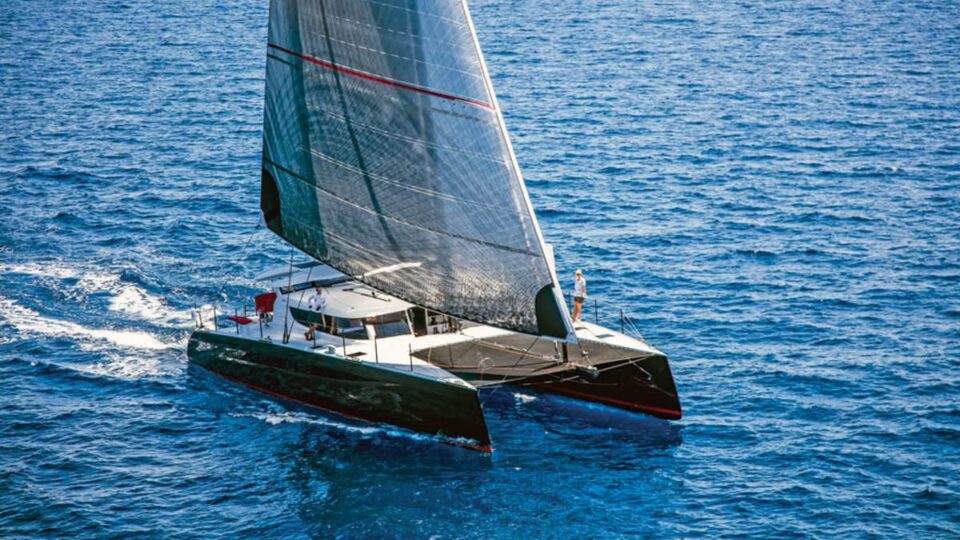
How Fast Do Catamarans Sail? Average Sailing Speed of a Catamaran
In most aspects, sailing a catamaran is very similar to sailing a monohull. If you learn to sail on a monohull then most of the skills are transferable. But, there are a couple of subtle differences that we will analyze further in this article. A catamaran is generally more balanced on the water and can be faster than a multi-hull vessel. And, cruising on a sailboat with a cat hull will be much faster than cruising on a sailboat with a monohull. Therefore, a catamaran hull is able to achieve the speeds of a racing monohull and is also more comfortable to sail on.
A tri-hull is even much better as they’re designed towards the performance end of the spectrum. And that is why they double the speed of a racing monohull. So, let’s analyze this subject further in this article and see what’s the average sailing speed of a cat. Follow me!
Catamaran Vs Monohull Speed: Are Cats Faster than Monohulls?
Not all cruising cats are always faster than an equivalent length monohull. But, many well-designed and balanced multihulls can easily surpass the speed of their monohull cousins. And, it’s not fair to mass all cats into one example, but performance cruising catamarans like the Nautitech or Neel trimarans distinguish from others. Their narrow waterline beams, hull chines, deep and fine keels, and rudders as well as efficient sail plans will typically be faster than the average cruising monohull.
“The fun of sailing is proportional to the speed of sailing”, as an American designer, L. Francis Herreshoff, said. And, it’s basically true because when we sail and see another boat heeling in the breeze, we also feel we want to do the same. This is because for many sailors speed means much more than just fun. You should, however, consider keeping your cat as light as possible if you want to maximize speed. I know that keeping your sailboat light is difficult but it’s of importance if speed is your main goal.
Keep in mind that a boat’s speed has won wars and has also been a contributor to safety. In the past, a fast warship was able to outmaneuver its adversary or escape from a boat with more firepower. And just as proven in history, the speed of a sailboat is important and provides a faster boat with more options.
Monohull VS Catamarans Differences
- When tacking, you must work hard to keep your speed consistent in the tack and always ease the mainsheet to avoid “windvaning.” When the larger mainsail on a catamaran attempts to turn the boat back towards the wind, this is known as windvaning.
- On a monohull, you must be extremely cautious about an unintended gybe. Meaning that you must gybe much more slowly. On a catamaran, you can take advantage of the increased speed and sustain it while gybing to help depower the main.
- On a monohull, and when winds increase, the boat starts heeling. This automatically informs you that you have too much sail up and it’s time to reef. And, as catamarans don’t heel, you have to be very careful when to reef the massive main. Most of the time, you will throw in the first reef at 18-20 knots of wind speed. The second reef will be put as the wind gets closer to 23-25 knots. The above-mentioned always depend on the size and type of your vessel.
Wind as a Main Factor for Speed
Thanks to tech evolutions in radar, satellite, and computer technology, a five-day forecast is as accurate as a two-day forecast was back in 1980. A multihull’s higher speed also contributes to easier and safer planning of ocean passages around weather windows since exposure time will be less. Moreover, meteorological prediction for shorter periods is far more accurate. Keep in mind that when sailing faster you also introduce the concept of apparent wind to the strategy of efficient sailing.
Multihull speed upwind? Sailing upwind, the catamaran usually experiences more apparent wind across the deck since it’s sailing faster. Therefore, the sails will feel more pressure, which will make the boat perform even better. And, of course, the concept of apparent wind contributes to the joy of sailing, as it adds another dimension to it. When sailing towards a downwind destination, fast multihulls are able to sail at smaller wind angles. Subsequently, this brings the apparent wind forward of the beam, hence optimizing the angle of attack on the sails.
While cats will fly gennakers, code-zeros, or asymmetric spinnakers, monohulls mostly set symmetric spinnakers to the poles. And most importantly, their boat speed will often cancel out the true wind and will reduce the apparent wind and performance. The faster the multihull is the more it is able to take advantage of the apparent wind and tack downwind towards its destination. Although it might be sailing twice the distance, it will arrive at the downwind mark quicker because its Velocity Made Good (VMG) will be faster.
>>Also Read: How Fast is a Laser Sailboat? Laser Sailboat Top Speed
Performance Characteristics
Bear in mind that cats require four times the power to double their speed. But, a mono-hull vessel requires eight times the power to double the speed. This is due to the fact that a cat has less resistance in the water. However, this is great in terms of conserving and using less energy. Catamarans are also more stable in the water. This stability is effective at resisting heeling or capsizing. In other words, a multi-hull vessel requires four times the force to capsize as a similar-sized mono-hull vessel.
Most of the time, sailing in a catamaran is smoother and facilitates activities that are not always possible on a mono-hull sailboat. In addition, as catamarans have less water resistance, they are generally faster than mono-hull vessels. As their hulls are smaller, this means that they have a smaller bow wave to fight. The bow wave is a wave created by the displacement of water by the bow of a ship. After a certain speed, the boat has to start hauling itself over its own bow wave. Meaning that the larger hull a boat has, the larger its bow wave will be and the more power will be required in order to fight it.
Since catamarans have two small and narrow hulls, they don’t have much of a bow wave. This is one of the reasons they are normally quicker than a monohull vessel of comparable size. Catamarans can travel at speeds of up to 30% faster than monohull boats. Catamarans have the disadvantage of taking longer to transform than monohulls.
Lastly, the thing that makes monohulls harder to sail is heeling and smaller spaces. In stronger winds, monohulls tend to heel. This results in making most tasks a bit more difficult to perform. Whether you’re heading forward to reef, trying to winch in a sail, or move about the boat, sailing on a heeling boat is always more difficult. However, cats have extra stability and room, and this allows for much easier movement around the boat as they do not heel. And, for this reason, catamarans are often considered easier to sail.
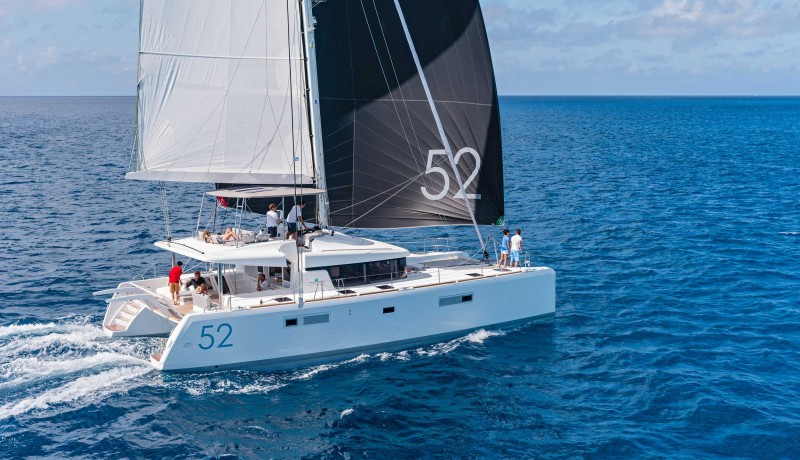
How Fast Are Catamarans Compared To Other Boat Types?
There are two main factors that determine the speed of ships. The first one is the hull type. There are hulls that stay beneath the water more or less than others. But, keep in mind that the less the hull is underwater, the faster it can go. This is due to the fact that the less of the hull underwater, the less the drag created when sailing. The other factor is the length of the boat. And, reasonably, the longer the boat, the faster it can go. Every boat has a maximum hull speed that can’t be exceeded. This can only happen in case the boat can plane on the water’s surface or be lifted on hydrofoils. For most boats, the longer the boat, the higher the maximum hull speed is.
Sailing catamarans typically average about 10 knots while pontoon boats average about 16 knots. As for powerboats, they can average anywhere between 30 and 50 mph. Most average sailboats are designed with monohulls and they average from 6 to 9 knots depending on wind conditions. Generally, sailboats average between 8 and 12 mph, again depending on weather conditions. This includes mono-hull between 6 to 8 mph and cats or trimarans between 9 and 10mph.
Speed and Comfort Considerations For Cats
You have a lot of choices if you choose to buy a catamaran. You have the option of prioritizing speed or comfort. After you’ve decided to buy a catamaran, the type of catamaran you can consider is determined by where you’ll be using it and what you’ll be doing with it. In addition, make sure that you look at what type of water you will be traveling in, your crew members, and what type of speed you want to achieve.
Storage is an important consideration to make before purchasing a catamaran. Due to the beam, or width, of a catamaran versus a regular mono-hull vessel, you are often charged for two slips if you wish to store your boat in a marina. Moreover, catamarans are a great option for those who get seasick because they have a more stable ride and more open air space. You have more windows and visibility since the living quarters are not within the hull and below the water’s surface.
Sailing and power catamarans are both great choices. In addition, for low winds or conditions such as docking in a marina, sailing catamarans may be equipped with backup power engines. Twin-engine catamarans can have more power and precision than mono-hull vessels.
>>Also Read: How Fast Can Sailboats Go?
Main Advantages of Catamarans
- Space! If you want to opt for more interior and exterior space then the two separate hulls of a catamaran can often double the amount of social space than a monohull of the same length.
- Catamarans are far more stable than monohulls. For this reason, they don’t heel when sailing, and are less prone to rocking when at anchor. This factor also contributes to comfortable sailing.
- Catamarans have a shallow draft which allows them to enter shallower areas. Keep in mind that in the South Pacific, most lagoons are 6 to 8 ft in depth. This depth doesn’t allow for monohulls to enter, but a catamaran can easily enter these areas.
- Stability is another big plus of cats. A cat isn’t that susceptible to the effects of wave action and it also doesn’t heal the way a monohull does. Therefore, it’s much easier to walk around on deck and within the interior of the cat while underway.
- In terms of speed, and mostly for downwind sailing , cats are faster than monohulls. This particularly applies to downwind runs, reaches, and broad reaches.
- More light, customizable, and airy living area. On a catamaran, the living space is usually situated in the middle of the boat and built on the bridge deck. But, in a monohull you go down into the hull where it is darker and less airy.
- More storage space and room for extra systems, provisions, and general sailing equipment. These may include air conditioning, heaters, oven, watermakers, generators, larger fridges, and freezers, etc. And, if you’re a liveaboard, then living on a cat is far more comfortable than living in a sailboat. You have more interior, exterior, and storage space as well as stability and speed in terms of sailing performance.
- Many modern cats have flybridge helms. And of course, no monohull achieves this visibility from the helm provided on most modern catamarans.
- The galley, main salon, and cockpit are all located on one level , above the waterline.
- Because the majority of living space is above the waterline , there’s a better flow of ventilation on a cat making the need for air conditioning somewhat less important during the daylight hours.
- When you plan to set sail, you almost never have to rush around stowing stuff or using bungee cords to hold things in place. Except in relatively rough waters, most things stay put.
- Since catamarans lack a large, heavy keel filled with lead, they can float even if they’re holed. Production cats are constructed with so much buoyancy that sinking them is nearly impossible.
- Catamarans are usually easy to dock because you have two motors and two rudders. Additionally, there’s also no need for a bow thruster.
- Most catamarans are able to turn 360 degrees within their own length.
Average Sailing Speed of Catamarans
| Sport Catamarans | 30 knots |
| Cruising Catamarans | 15 knots |
| Racing Catamarans | 45 knots |
| Power Cruising Catamarans | 70 knots |
| Swath Catamarans | 30 knots |
How Fast Do Catamarans Sail? – The Bottom Line
Bear in mind that not all catamarans are created equal. In other words, catamaran speed is relative. The most important benefit of the speed of a multihull is the ability to outrun bad weather. Meaning that you’re able to average 9-10 knots on a catamaran rather than 6-7 knots on a monohull. Subsequently, this will give you more options in your strategy to avoid bad weather. In general, sailing catamarans typically average about 10 knots. Higher maximum and average speeds are what makes cats distinguish as well as their stability. These are the most important characteristics which makes many sailors prefer cats rather than monohull boats.
Peter is the editor of Better Sailing. He has sailed for countless hours and has maintained his own boats and sailboats for years. After years of trial and error, he decided to start this website to share the knowledge.
Related Posts

Atlantic vs Pacific: Which is More Dangerous for Sailing?

Lagoon Catamaran Review: Are Lagoon Catamarans Good?

Best Inboard Boat Engine Brands

Are O’Day Sailboats Good? A Closer Look at a Classic Brand
- Buyer's Guide
- Destinations
- Maintenance
- Sailing Info
Hit enter to search or ESC to close.

How Fast Can a Sail Catamaran Go?
Sailing on a catamaran is an exhilarating experience, and one question that often comes to mind is, “How fast can a sail catamaran go?” Catamarans are known for their speed and stability, making them a popular choice among sailing enthusiasts. In this article, we will explore the factors that contribute to a sail catamaran’s speed and discuss some of the fastest recorded speeds.
Factors Affecting Catamaran Speed:
There are several factors that determine how fast a sail catamaran can go. Let’s take a closer look at them:
1. Hull Design: The design of the hull plays a significant role in determining the speed of a catamaran.
Catamarans typically have two parallel hulls connected by a deck structure, which reduces drag and increases stability. The hull shape, including its width, length, and weight distribution, affects how the boat moves through the water.
2. Sail Area: The size of the sails directly impacts the speed of a sail catamaran.
Larger sails capture more wind energy and generate more power to propel the boat forward. Sail area is measured in square feet or square meters and is an important consideration for maximizing speed.
3. Rigging: The rigging system refers to all the components that control and support the sails, including masts, booms, and rigging lines. Properly tensioned rigging ensures efficient transfer of wind energy from the sails to propel the catamaran forward.
4. Wind Conditions: Wind strength and direction significantly influence how fast a sail catamaran can go.
More wind means more power to drive the boat at higher speeds. However, excessive wind can also pose challenges in terms of handling and control.
5. Sail Trim: Sail trim refers to the adjustment of the sails to optimize their shape and angle relative to the wind. Proper sail trim helps to maximize speed by reducing drag and harnessing the wind’s energy most effectively.
6. Weight: The weight of a catamaran, including its hulls, rigging, and equipment, affects its overall performance. Lighter catamarans tend to be faster as they have less resistance in the water.
Now that we have explored the factors influencing catamaran speed let’s delve into some of the fastest recorded speeds:
Fastest Recorded Catamaran Speeds:
1. Sailrocket 2: In November 2012, the Sailrocket 2 set a new world sailing speed record of 65.45 knots (75.23 mph or 121 km/h). This high-performance sailboat was specifically designed for speed and featured advanced hydrofoil technology.
2. L’Hydroptère: L’Hydroptère is a hydrofoil trimaran that has achieved remarkable speeds.
In 2009, it set a world sailing speed record of 51.36 knots (59 mph or 95 km/h). This innovative design uses hydrofoils to lift the hull out of the water for reduced drag and increased speed. Paul Larsen’s Vestas Sailrocket 2: Paul Larsen broke his own record in November 2012 with an impressive speed of 65.23 mph or 121 km/h) in Walvis Bay, Namibia. This achievement showcased the immense potential of catamarans for achieving high speeds on water.
In conclusion,
The speed at which a sail catamaran can go is determined by various factors such as hull design, sail area, rigging, wind conditions, sail trim, and weight. With the right combination of these elements, catamarans have achieved astonishing speeds, often surpassing those of traditional monohull sailboats. Whether you are a sailing enthusiast or simply curious about the capabilities of catamarans, exploring their impressive speed potential is sure to leave you in awe.
- Hull Design: Determines stability and drag.
- Sail Area: Larger sails generate more power.
- Rigging: Proper tension for efficient energy transfer.
- Wind Conditions: More wind means more speed.
- Sail Trim: Optimizing sail shape and angle.
- Weight: Lighter catamarans have less resistance.
- Sailrocket 2: Set a world record at 65.
- L’Hydroptère: Achieved a record of 51.
- Vestas Sailrocket 2: Broke the record again at an impressive speed of 65.
6 Related Question Answers Found
How fast can a catamaran sail, how long does it take to sail around the world on a catamaran, how close to the wind can a catamaran sail, can a catamaran sail across the ocean, how fast can you sail around the world, can a catamaran sail around the world.

Daniel Bennet

A Complete Catamaran Guide
- Post Written By: Boater Jer
- Published: January 26, 2020
- Updated: November 27, 2020

Disclaimer: You might notice that we recommend products in some articles. We may earn a commission for referring you if you click the link and buy a product.
We only recommend products we’ve tried/tested/own (that’s why you won’t find thousands of affiliate links on my site). If you have experience with one of the products we’ve mentioned, please share your experiences in the comments at the end.
There you are, out on the water when a strange craft approaches. Is it a sailboat? It sure looks like one until it turns to face you. That’s when you notice this boat doesn’t have just one hull. It has two hulls and it’s called a catamaran.
Catamarans are unique, and highly stable watercraft. We’ll explore all the ins and outs of sailing the waters in one of these weird, and awesome multi-hulled craft. Join me as we explore the wild world of sailing catamarans.
A History Of The Catamaran
It is believed that the first people to use a catamaran design were those living in Australasia.
The succession of boat design in this region was actually very interesting. The beginning of boats in the area was simple, albeit conventional rafts. These were fashioned from logs strewn together with plant fiber lashings such as those formed using bamboo fiber.
Catamaran Evolution
The conventional raft gave way to a minimal raft. This design was basically a conventional raft with two cross beams added in the form of logs. These would be eventually hollowed out to improve buoyancy.
The next step in the evolution of boats in the Australasian region was the double canoe. This proved to be the first real catamarans.
After some time, the form evolved further into the asymmetrical double canoe design. In this design, one canoe was large and the other attached canoe was smaller.
The asymmetrical design quickly evolved into the single-outrigger boat like the one shown in the photo below.
The final stage of the evolution of the catamaran in the region was to gain a second outrigger. This in effect created the trimaran with the single central hull and dual outriggers.
Eye Witness Accounts Of Catamarans
In 1697, William Dampier wrote of witnessing a type of seafaring vessel off the coast of Coromandel. He noted how the locals called the type of boat a catamaran. He also noted that it had multiple hulls (logs) and that they were small vessels that the person operating would have to hang partway into the water, straddling the hull (log).
The name catamaran came from the Tamil. And yet, it was easily applied by the European visitors to the two hulled sailing vessels that sped across the water in the region.
Although Dampier may have described the catamaran in the 1690s, the type of boat was actually used as early as the 5th century by the Tamil Chola dynasty. They used boats to move their troops from one island to another. Using this design of boat allowed them to travel heavy, travel quickly and was partially responsible for the conquering of neighboring Burma, Malaysia, and Indonesia.
Building A Boat – Basics Of Catamaran Construction
A boat is usually thought of as being a single-hulled vessel that travels along the surface of the water. It can have multiple types, shapes, and designs of the hull. However, it is often only thought of as having a single hull. But, what if it had two hulls? Would that be like taking two separate boats, and making a raft over both of them? In essence, that is exactly what a catamaran is: two boats made into one.
Advantages Of Multiple Hulls
- More stability than a monohull
- Wide supporting base allows for larger sails than monohull craft of the same length
- Hull does not require the deep-running keel of a standard monohull sailboat
- Less hull drag in the water than a monohull
- Less power required to drive a catamaran forward than a monohull boat
Disadvantages Of Multiple Hulls
- Due to multiple hulls, construction is more expensive than a monohull design
- Catamaran speed relies on lightweight materials to make a lightweight craft. This also drives up the cost of construction.
- Extra engineering requirements for multi-hull craft also increase the cost of construction.
Conclusion? Well, it looks to me like everything about catamarans points towards superiority over monohulls in nearly every way. But, you get what you pay for. I think the same thing likely applies to cars too. For instance, I have a performance car that cost me about 10k more than the equivalent non-sports car within the same class.
Yet to drive the vehicle, it performs so much better than the normal version of the car, it really speaks volumes to the difference between a common vehicle, and a performance one.
Speaking of performance vehicles, let’s take a look now at the different kinds and uses of a catamaran.
Catamaran Types
Commercial catamarans – ferries.
One of the most common uses for a catamaran is the commercial use of the vehicle design when it comes to ferries. This is likely due to the wide, flat deck possibilities of a catamaran versus a monohulled boat. Not only that, but the catamaran is also a much more stable bodied vessel. This again makes it a superior design for transporting larger land vessels like trucks and so forth. They can easily drive on the ferry without fear of the ferry tipping over.
Some ferries are designed for taking vehicles, like the one you might find in the city of Toronto. Where it transports cars from the mainland to Toronto Island. Others are designed specifically with the sole purpose of transporting people. I took a look at one such ferry that operates in Germany. Take a look at the following case study.
Commercial Use Case Study – The Ferry
The FRS Helgoline is a ferry catamaran operating out of Flensburg, Germany, close to the Danish border.
According to the ferry company’s website, the ferry runs using four main engines which are run to a capacity of 12,182 hp combined. This blasts this ferry at a speed of 35 knots or 65 km/hour. This is equivalent to 40 miles per hour. That’s pretty good considering the size and weight of the ship body this catamaran can carry.
Speaking of capacity, the ship can carry 680 passengers. At 56.4 meters long (185 feet) by 14 meters wide (45.9 feet), that’s a decent passenger capacity.
Catamaran Passenger Capacity Versus Monohull Boat Passenger Capacity
The general rule for calculating passenger capacity for a boat is as follows.
Length x Width / 15 = Passenger Capacity
Therefore, the FRS Helgoline should have a calculated capacity calculated as follows.
185 x 45.9 / 15 = 566
But it actually has a capacity of 680 which is a 20% increase in capacity over a standard monohull.
For comparison, let’s look at a superyacht. A 48.5m (159 feet) long by 10.7m (35 feet) beam (width of the boat) Palmer Johnson Supersport 48 (valued at about $28.5 million dollars) should have a capacity calculated as follows.
159 x 35 / 15 = 371
In short, 26 feet of difference in length equates to 309 fewer passengers. It is almost half of the capacity of the catamaran at 26 feet longer length.
Photo courtesy of https://sysyachtsales.com/
Commercial Catamarans – Service Vehicles
Although Catamarans are typically used as ferries due to their stability and ability to carry wide loads on their flat decks, there are many different service catamarans out there as well. From a support vessel to a crew transfer or search and rescue, catamarans are a solid and stable platform to build a ship on.
This is the Ardea which is a 20 meter (65.6 feet) catamaran to be used for crew transport and as a support ship. This ship was built by the Echo Marine Group and delivered to Western Australia in early 2019. This particular vessel is in the service of the Cape Preston Sino Iron Project.
Catamarans are used all around the world, for a variety of tasks, not just ferries or support craft.
Commercial Catamarans – Cruise Lines
Now these are the catamarans we all want to be aboard, aren’t they? Due to the wide stance, these ships can feature massive halls and wide-open interior areas. These ships are stable, and some would say even more stable and safer than monohull design ships.
There are many cruise ship catamarans in use today around the world. Some of the more ‘famous’ catamaran cruises are those which investigate the Galapagos Islands. There are several high-end, small fleet, cruise lines operating to the Galapagos which utilize catamaran design vessels as their primary ship type.
These ships can be extremely comfortable and stable and often offer some reprieve to those who may otherwise feel seasick. It won’t stop the feeling, but the more stable the hull, the less the boat rocks around.
Military Catamarans
Catamarans make excellent military transport vessels. They are stable and the potential to have a large, flat and wide deck for transporting land craft, troops or acting as a landing pad for vertical take-off aerial craft. The stability of the two hulls makes the vessel an excellent candidate for military use, and thus it is used for said purpose.
As you can clearly see in the image of the USNS Spearhead, the rear of the vessel has a moveable ramp that can be used for loading and unloading land vehicles. The interior bay of the craft is visible in the image as well, a large area for storage of vehicles, supplies and more. The crane arm on the back of the ship also shows how it is a versatile craft, set up to act as an excellent support craft with a helicopter landing pad and ample storage and freight capacity.
Recreational Catamarans
Catamaran Personal WatercraftThe wind is in your hair, the warm spray from the hull cutting over the edge of each wave as you skip over the water. That is life, let me tell you. Personal watercraft have come a long way over the years and the small one, two, three and four-person catamarans have come a long way as well.
Depending on the options, you can get a small one or two-person catamaran for as little as $1500 new. That might be an inflatable though. There are some very nice, rigid hull designed catamarans for 1-4 people that range from $3500 to $15000. And these are basically open, personal watercraft like that shown in the image below.
Using a small catamaran can be quite challenging to learn at first. Sailing is not for the faint of heart. It requires skill, technique, knowledge of the wind and sea, and a bit of hard work. But it can be fun, rewarding and a great way to catch some sun and fresh air out on the water. It’s a relatively GREEN sport as well. Given the use of sails over gas-powered motors that is.
‘Sailing Cats’ – Sailing Catamarans – Yacht & Luxury Class
Here’s where we get into the dreamy boats of the rich and famous. I priced out a small 43’ luxury Leopard 40 sailing catamaran. Even before I added any extras at all, the base price was $399,000 USD. I imagine if I added a few of the multiple extras available, and some tax, freight and that sort of thing, I’m easily in half a million dollars. And that’s the smallest base model.
There are all kinds of luxury catamaran shipbuilders across the world. From Asia to Europe and The Americas, it seems any major boating country has at least one company building luxury catamarans. It’s weird that you don’t see more of them on the water though, don’t you think?
Being sailing vessels, these luxury cats require some training in sailing before you get behind the wheel. And considering the price point, I would definitely want to be at least a semi-decent sailor with some good few years experience under my belt before I would comfortable at the helm of a half-million-dollar sailing cat. It’s all relative I suppose. I imagine a billionaire might bat an eye at the prospect of wrecking a half-million-dollar boat. But to me, and most of you reading this, that’s likely a lot of money.
‘Power Cats’ – Powered Catamarans
The powered catamaran is one of my favorite boats. They have sort of a muscle car appearance with the wide and often tall front end of the boats. I find it to be reminiscent of a large air intake on the front hood of a rally race car like the Subaru WRX, for instance. These boats are fast, they are stable and handle very well. Catamarans are often considered the boat of choice for long sea voyages due to their stability.
A powered catamaran will definitely cost more than a powered monohull boat of the same length. Why? Well, the powered catamaran has one crucial downside. That is, it needs two engines. One for each of the two hulls. Otherwise, it’s off balance for propulsion. These two engines or motors have to be in sync with each other or again, the propulsion will be off-balance. Because they have two motors, they have double the maintenance when it comes to maintaining the propulsion system.
More components also means a greater chance of things breaking down. In essence, it doubles the chances of the ship having a motor break down. The saving grace is that should one motor break, they have a backup, even if it does mean very unbalanced propulsion. In contrast, a monohull vessel of the same length may only have half the chance of motor failure due to only having one motor, but if that one motor breaks, then what? Call for help, that’s what. A cat would have a struggling chance to get itself back to port. A monohull would be dead in the water unless it was carrying spare parts or another motor onboard somewhere.
Catamaran Frequently Asked Questions
What is a catamaran cruise.
A catamaran cruise is simply a cruise on a dual hull design boat. Often used for river cruises, the catamaran which is used as cruise ships are often considerably smaller than their giant monohulled counterparts.
What is the purpose of a catamaran?
A catamaran is a design for a boat that utilizes two hulls. Due to the flat, platform-like-potential for the deck of the boat, the catamaran is often purposed with transporting materials, vehicles, and people. For instance, catamarans are quite often used as ferries.
Is catamaran safe?
Catamaran are very safe water craft. The design of riding on two hulls separated by a gap in between, in essence is like giving a car a double-wide wheel base. The wider the stance, the more stable the craft, from side to side anyway. And if the length of the boat is proportional to the width, then it becomes an extremely stable craft. That is why catamarans are often considered the best to be used for long voyages. Yes, catamaran are safe.
What is the difference between a catamaran and a sailboat?
A traditional sailboat is a deep, monohull vessel that has at least one mast extending high into the air above the deck to hold sails. A catamaran refers to the design of a dual-hull boat and really has nothing to do with sails. Although, catamaran do make excellent sailing boats as well, they are quite capable of acting as power boats and do not require sails if they have the correct amount of powered motors to propel them. Sailboats, although also able to be powered if a motor is provided, are traditionally monohull and wind-powered exclusively.
Do catamarans have small interiors?
The size of an interior cabin on a boat is typically proportional to the size of the boat itself. If a catamaran has above-deck cabins, they will likely be able to be of a larger design than those you would find on deck of a monohull boat. This is because a catamaran has a much wider footprint than a monohull boat of the same length. This extra width would allow for larger on deck cabins.
How much does a catamaran cost?
A personal watercraft (1-2 person) inflatable catamaran will run you anywhere from $1500-$12000 USD, depending on the quality and features. The rigid hull catamarans of the same size start at about $4500 USD.
A small cabin cruiser type of catamaran will typically start at about $60000 for a small base model and the price just goes up and up depending on size and features.
For Instance, a 40’, 3 cabin with 1 washroom cat will cost you about $500,000 USD for the base model. They are considerably more expensive that a monohull of the same length. However, the trade-off is greater stability and a smoother, more comfortable ride.
Is a catamaran more work to maintain?
Technically yes. Due to having two hulls and if powered, two motors and likely also water jets, this means you have double the oil changes of a boat that would have a single motor. Once you get past the basic engine and hull maintenance, a catamaran is not that much more work than a monohull ship of the same length.
The trouble with catamarans in terms of maintenance, is that once they reach a certain length, the width becomes more than a standard lane on the road. That being said, if you ever need to transport the boat via land, it can be quite the challenge. Especially if you need to pay to have a police escort for an extra-wide trailer. And special licensing might be involved as well.
What is the difference between a catamaran and a trimaran?
A catamaran is a dual hull boat. In other words, it has two hulls. A trimaran has three hulls.
Is a catamaran considered a yacht?
According to Oxford dictionary, a yacht is a medium-sized sailboat equipped for cruising or racing. A catamaran, on the other hand, is a boat with two hulls. Therefore, a catamaran can most certainly also be a yacht. And likewise, if a yacht has two hulls, then it is a catamaran as well.
Can you get seasick on a catamaran?
Seasickness occurs when a person feels nauseous from the swaying motion of a rocking ship. These feelings may be lessened on a catamaran, due to their extra stability. However, a catamaran may be slightly more stable than a monohull of the same length, but it is still a boat. And it will still make someone who experiences seasickness continue to feel the ill effects.
Are catamarans more stable in rough seas?
Catamarans are known to be more stable than monohull ships of the same length. This is why catamarans are often the ship type of choice for long sea voyages due to their stability.
Why do catamarans capsize?
Catamarans are not known for capsizing. The larger vessels that is anyway. But, it does happen from time to time. Catamarans are known for their stability, so typically if a capsize event should occur, it is typical for them to be extreme circumstances.
Personal watercraft catamarans are a different story though. These are in fact known for tipping over. Not because they are less stable than their monohull counterparts of the same length. But instead, because they are able to go considerably faster than monohull personal watercraft of the same length (not including powered craft though). This is due to the sailing cats being able to have a larger sail than a small monohull sailboat of the same length.
Due to the extra sail, they are able to travel faster than monohull sailboats of the same length. This allows them to whip around on the water and at higher speeds, whipping your cat about quick can easily send it over sideways. Extra speed means fast turns carry momentum in the direction of travel and that extra speed equates to tipping over if turned too fast. To sum up, they capsize due to user error or extreme events.
Which is safer, a catamaran or a monohull?
Due to the extra stability of having a wider footprint than a monohull, a catamaran of the same length is the safer vessel.
Are catamarans safer than sailboats?
The same rule applies to stability versus the length of the hull. A cat will always be the more stable length for length. However, due to their ability to go much faster than a monohull sailboat, this kind of cancels out some of the added safety due to stability. With that in mind, they may just be about the same but there is one generalization we can make when comparing the safety of catamarans vs sailboats: At the same speed, and of equal length, sailing or power catamaran will be safer than a monohull sailboat.
How fast can catamarans go?
The speed a catamaran can go is entirely dependent upon the hull design, weight of the vessel, the strength of propulsion (be it wind or powered) and so on. The general rule is that in terms of sailing cats vs monohull sailboats, a cat of equal length can typically go faster than a sailboat.
In terms of powered cats vs powerboats, a powered catamaran will typically require less energy to move forward than a monohull of the same sort of hull design (but monohull of course) and thus a cat should, in theory, be able to go faster than a monohull when both are using propulsion that is equal in power.
Bibliography
- Wikipedia – Catamarans
- Mahdi, Waruno (1999). “The Dispersal of Austronesian boat forms in the Indian Ocean”. In Blench, Roger; Spriggs, Matthew (eds.). Archaeology and Language III: Artefacts languages, and texts . One World Archaeology. 34 . Routledge. pp. 144–179. ISBN 0415100542 .
- Wikipedia – Spearhead -class expeditionary fast transport
- https://www.tiki-toki.com/timeline/entry/169516/Origin-of-the-catamaran/#vars!panel=1620923!
- https://www.austal.com/ships/passenger-express-56
- https://www.adventure-life.com/galapagos/galapagos-catamaran-cruises
Boating Gear
Take a look at our Recommended page for a variety of items. Here are some of the things you can expect:
- GPS And Fish Trackers
- Hitch And Trailer Supplies
- Lifejackets And Specialty Clothing
- Boating Books And More!
More From Boating Guide Magazine
- Pontoon Boat Basics
- The Complete Runabout Boat & Trailer Towing Guide
- Winterizing Your Boat
- Boating Gear Requirements For Canada And USA Waters
- Aluminum vs. Fiberglass Bass Boats
- Better Boating At Night & How To Survive The Darkness
- Staying Safe On A Catamaran: 24 Essential Tips
- Can A Catamaran Capsize?
- 4 Common Types Of Propulsion For Boats
Return To Home * About Boating Guide * About The Author
fakewatches.is
Share this post with your friends.
- Tags: boat type , catamaran , catamaran basics , catamaran essentials , sailing
Subscribe to our Newsletter
Join us in our love for all things water. And Adventure.

Why Are Boat Steering Wheels So Big?
You see them on the water in summer or all year round, depending on where you live, boats, and lots of them. Riding on the water on a ship is calming and relaxing unless you are racing, then it can be exhilarating and action-filled! I have been on many boats of different shapes and sizes.
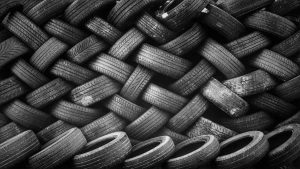
Boat Trailer Tire Guide
A boat trailer tire is something that is neglected by most everyday people. In other words, a tire is an underrated part. However, the main question arises that is a tire underrated, or is it just a myth? This section deals with the factors and facts that are related to the boat trailer tire. It’s
A Snapshop Guide To Boat Buying
A Guide to Buying Boats for a Smooth Sailing Adventure Looking for the ideal boat can feel like an arduous adventure. To begin your boating journey, a boat must be suitable for your requirements in terms of the quantity and quality of its lodgings, speed, maneuverability, overall look, and affordability based on your budget. Assuming

Does Marine Grade Plywood Warp and Rot? Is it Waterproof Plywood?
Updated April 27, 2021. Working on a boat build is a great and time-consuming endeavor. The last thing a boat builder wants is to use materials that will not be conducive to a wet environment. Moreover, one is likely asking the question, “Does marine grade plywood warp and rot?”. Although marine plywood avoids warping and

Boat Repair- The Truth About Eisenglass Vs. Vinyl
If you’re a boat owner, you must have come across eisenglass vs. vinyl. Yes, they’re world-famous materials used to make clear glass windows. Since they’re thin strips and durable, they don’t take up much space in the boat. However, when repairing the vessel, you might want to reconsider whether to install eisenglass or vinyl. Wondering

A Guide To Boat Seat Re-Upholstery Costs
Boat Seat Re-Upholstery isn’t as tough as you might think. Boat seats can receive damage from direct sunlight, rain, moisture, water, etc. Re-upholstering is the best way to recover your existing boat seats. Re-upholstery can be cheaper than replacing the entire boat seats, and you can either hire a professional or do it yourself. But

Boat Information By Type
© 2023 Boating.Guide, A Hyperwave Media Group Ltd. Publication.
Privacy Overview
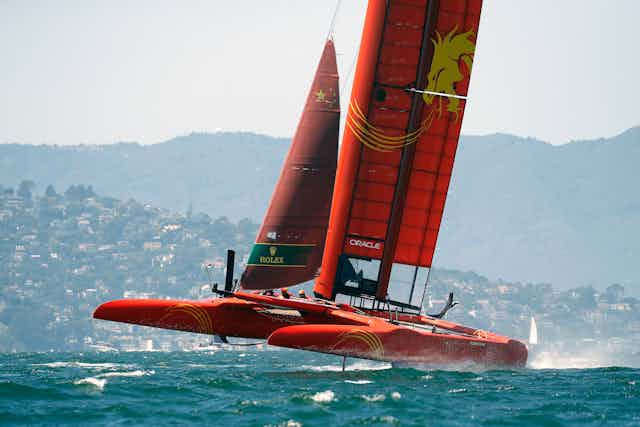
Sail GP: how do supercharged racing yachts go so fast? An engineer explains
Head of Engineering, Warsash School of Maritime Science and Engineering, Solent University
Disclosure statement
Jonathan Ridley does not work for, consult, own shares in or receive funding from any company or organisation that would benefit from this article, and has disclosed no relevant affiliations beyond their academic appointment.
View all partners
Sailing used to be considered as a rather sedate pastime. But in the past few years, the world of yacht racing has been revolutionised by the arrival of hydrofoil-supported catamarans, known as “foilers”. These vessels, more akin to high-performance aircraft than yachts, combine the laws of aerodynamics and hydrodynamics to create vessels capable of speeds of up to 50 knots, which is far faster than the wind propelling them.
An F50 catamaran preparing for the Sail GP series recently even broke this barrier, reaching an incredible speed of 50.22 knots (57.8mph) purely powered by the wind. This was achieved in a wind of just 19.3 knots (22.2mph). F50s are 15-metre-long, 8.8-metre-wide hydrofoil catamarans propelled by rigid sails and capable of such astounding speeds that Sail GP has been called the “ Formula One of sailing ”. How are these yachts able to go so fast? The answer lies in some simple fluid dynamics.
As a vessel’s hull moves through the water, there are two primary physical mechanisms that create drag and slow the vessel down. To build a faster boat you have to find ways to overcome the drag force.
The first mechanism is friction. As the water flows past the hull, a microscopic layer of water is effectively attached to the hull and is pulled along with the yacht. A second layer of water then attaches to the first layer, and the sliding or shearing between them creates friction.
On the outside of this is a third layer, which slides over the inner layers creating more friction, and so on. Together, these layers are known as the boundary layer – and it’s the shearing of the boundary layer’s molecules against each other that creates frictional drag.
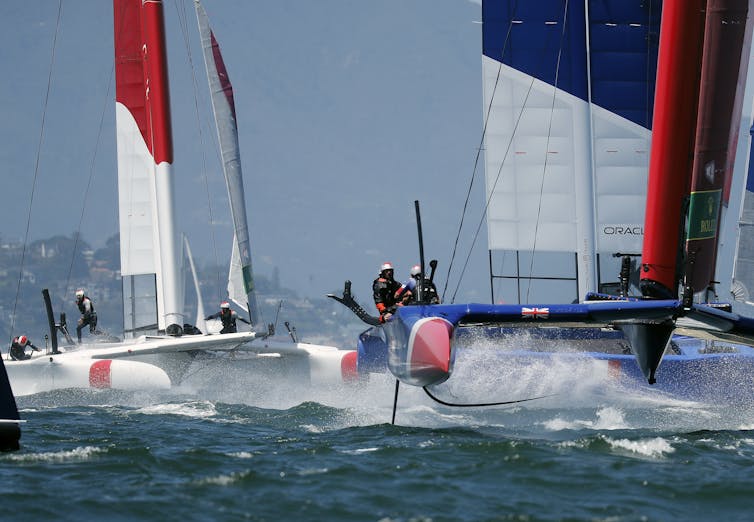
A yacht also makes waves as it pushes the water around and under the hull from the bow (front) to the stern (back) of the boat. The waves form two distinctive patterns around the yacht (one at each end), known as Kelvin Wave patterns.
These waves, which move at the same speed as the yacht, are very energetic. This creates drag on the boat known as the wave-making drag, which is responsible for around 90% of the total drag. As the yacht accelerates to faster speeds (close to the “hull speed”, explained later), these waves get higher and longer.
These two effects combine to produce a phenomenon known as “ hull speed ”, which is the fastest the boat can travel – and in conventional single-hull yachts it is very slow. A single-hull yacht of the same size as the F50 has a hull speed of around 12 mph.
However, it’s possible to reduce both the frictional and wave-making drag and overcome this hull-speed limit by building a yacht with hydrofoils . Hydrofoils are small, underwater wings. These act in the same way as an aircraft wing, creating a lift force which acts against gravity, lifting our yacht upwards so that the hull is clear of the water.

While an aircraft’s wings are very large, the high density of water compared to air means that we only need very small hydrofoils to produce a lot of the important lift force. A hydrofoil just the size of three A3 sheets of paper, when moving at just 10 mph, can produce enough lift to pick up a large person.
This significantly reduces the surface area and the volume of the boat that is underwater, which cuts the frictional drag and the wave-making drag, respectively. The combined effect is a reduction in the overall drag to a fraction of its original amount, so that the yacht is capable of sailing much faster than it could without hydrofoils.
The other innovation that helps boost the speed of racing yachts is the use of rigid sails . The power available from traditional sails to drive the boat forward is relatively small, limited by the fact that the sail’s forces have to act in equilibrium with a range of other forces, and that fabric sails do not make an ideal shape for creating power. Rigid sails, which are very similar in design to an aircraft wing, form a much more efficient shape than traditional sails, effectively giving the yacht a larger engine and more power.
As the yacht accelerates from the driving force of these sails, it experiences what is known as “ apparent wind ”. Imagine a completely calm day, with no wind. As you walk, you experience a breeze in your face at the same speed that you are walking. If there was a wind blowing too, you would feel a mixture of the real (or “true” wind) and the breeze you have generated.
The two together form the apparent wind, which can be faster than the true wind. If there is enough true wind combined with this apparent wind, then significant force and power can be generated from the sail to propel the yacht, so it can easily sail faster than the wind speed itself.
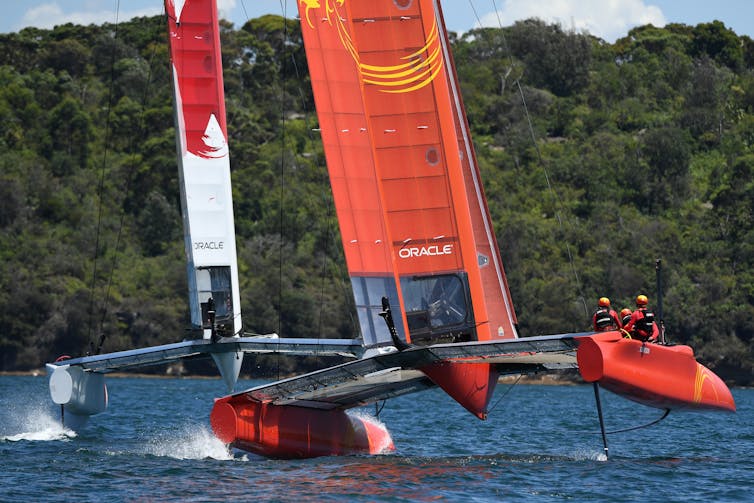
The combined effect of reducing the drag and increasing the driving power results in a yacht that is far faster than those of even a few years ago. But all of this would not be possible without one further advance: materials. In order to be able to “fly”, the yacht must have a low mass, and the hydrofoil itself must be very strong. To achieve the required mass, strength and rigidity using traditional boat-building materials such as wood or aluminium would be very difficult.
This is where modern advanced composite materials such as carbon fibre come in. Production techniques optimising weight, rigidity and strength allow the production of structures that are strong and light enough to produce incredible yachts like the F50.
The engineers who design these high-performance boats (known as naval architects ) are always looking to use new materials and science to get an optimum design. In theory, the F50 should be able to go even faster.
- Engineering
- Aerodynamics

Professor of Indigenous Cultural and Creative Industries (Identified)

Communications Director

Associate Director, Post-Award, RGCF

University Relations Manager

2024 Vice-Chancellor's Research Fellowships
Your source for the latest news on yachts, boats and more. Read through our articles to find out how to compare boats and find the right fit for you!
How fast are catamarans
Oct 26, 2020
less than a min
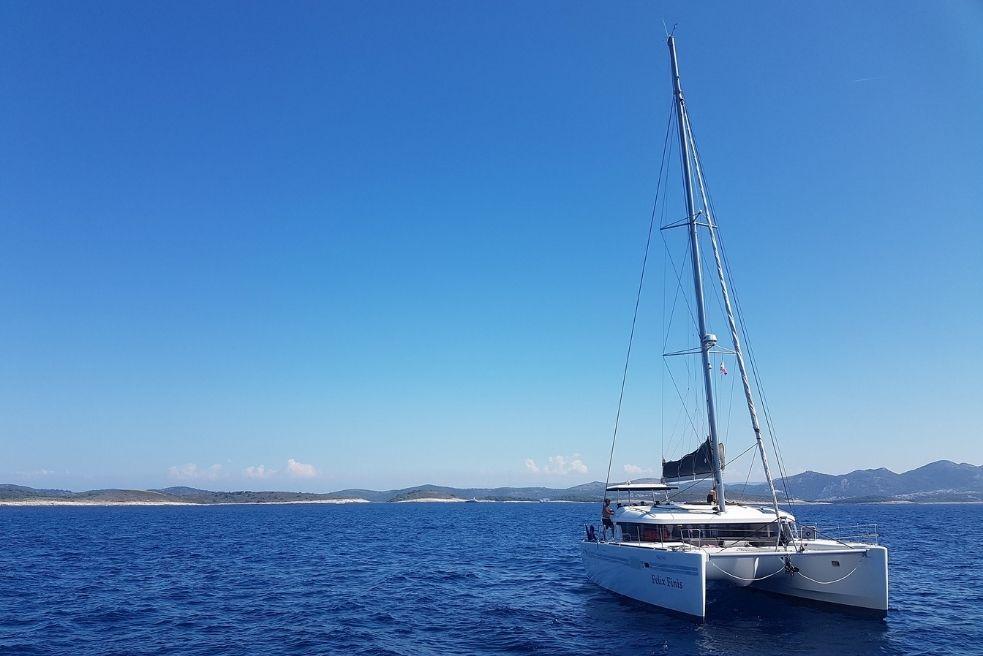
Catamarans are multi-hull vessels composed of two hulls. This geometry allows them to be balanced on water and in turn gain a great deal of speed. Compared to single-hull boats, catamarans are regarded as much faster. But how fast are catamarans actually ?
Catamarans come in various types and sizes. They start from 14 feet up to 100 feet. Each one can reach a different speed limit. Typically, a cruising catamaran sails at 15 knots . A sport cruising catamaran can reach 30 knots . A racing catamaran is somewhat faster and can sail at 45 knots . The power cruising catamaran is probably the fastest vessel and can travel at 70 knots .
One of the main features that make catamarans so fast is the integration of assisting foils that lift the boat off the water. In addition, catamarans are equipped with stability advancements that allow them to gain speed in the ocean.
To better understand how fast catamarans are , they are divided into three groups:
- The sport boats
- The racing ones
- The cruising catamarans
The sport catamarans are recreational vessels designed for a small crew. Their interior is limited as well. Most of them have no living quarters as they are only used for short trips. Some sport catamarans are also used for racing, however, the maximum speed they reach in ideal conditions is 40 knots .
Racing catamarans are used in ocean races and rallies. They are large yachts that can go up to 100 feet and sail at a maximum of 45 knots .
Cruising catamarans on the other hand are more comfortable vessels used for ocean crossing as well. They are equipped with luxurious living quarters. Because of their size, load and volume, these catamarans usually sail at 10 knots , with a maximum speed of 15 knots in ideal conditions.
Some catamarans on the other hand are fitted with powerful motors that favor speed over space. The most common catamaran of this category is the power cruising catamarans . These boats have living quarters and offer the same stability as sailing catamarans. However, the integration of a powerful motor allows these vessels to reach about 70 miles per hour . These catamarans are typically used for passenger travels to shorten the trip between two relatively close destinations such as the mainland and a not-so-remote island.
Power catamarans are also used by the military to transport items. They are particularly on-demand as they can sail in shallow waters as well.
In terms of their performance, catamarans have less resistance to water. Their hulls are smaller so they also have a smaller bow wave created by water displacement to fight. In addition, catamarans only need 4 times the power to double their speed, which is much less power than a monohull would require. Apart from using less energy, catamarans are also good at conserving energy.
Moreover, they are stable and can resist capsizing more than other vessels. They have twin engines that provide more control over speed and stability. Last but not least, catamarans offer smoother voyages and are great for entertainment.
All in all, catamarans can achieve a 30% faster speed than monohulls. Learn more interesting facts about catamarans with TheBoatAPP . Compare these vessels at TheBoatDB . Follow our blog for more interesting facts!
You might like these too

Electric and Hybrid Boats – The Future of Sailing
Aug 23, 2022
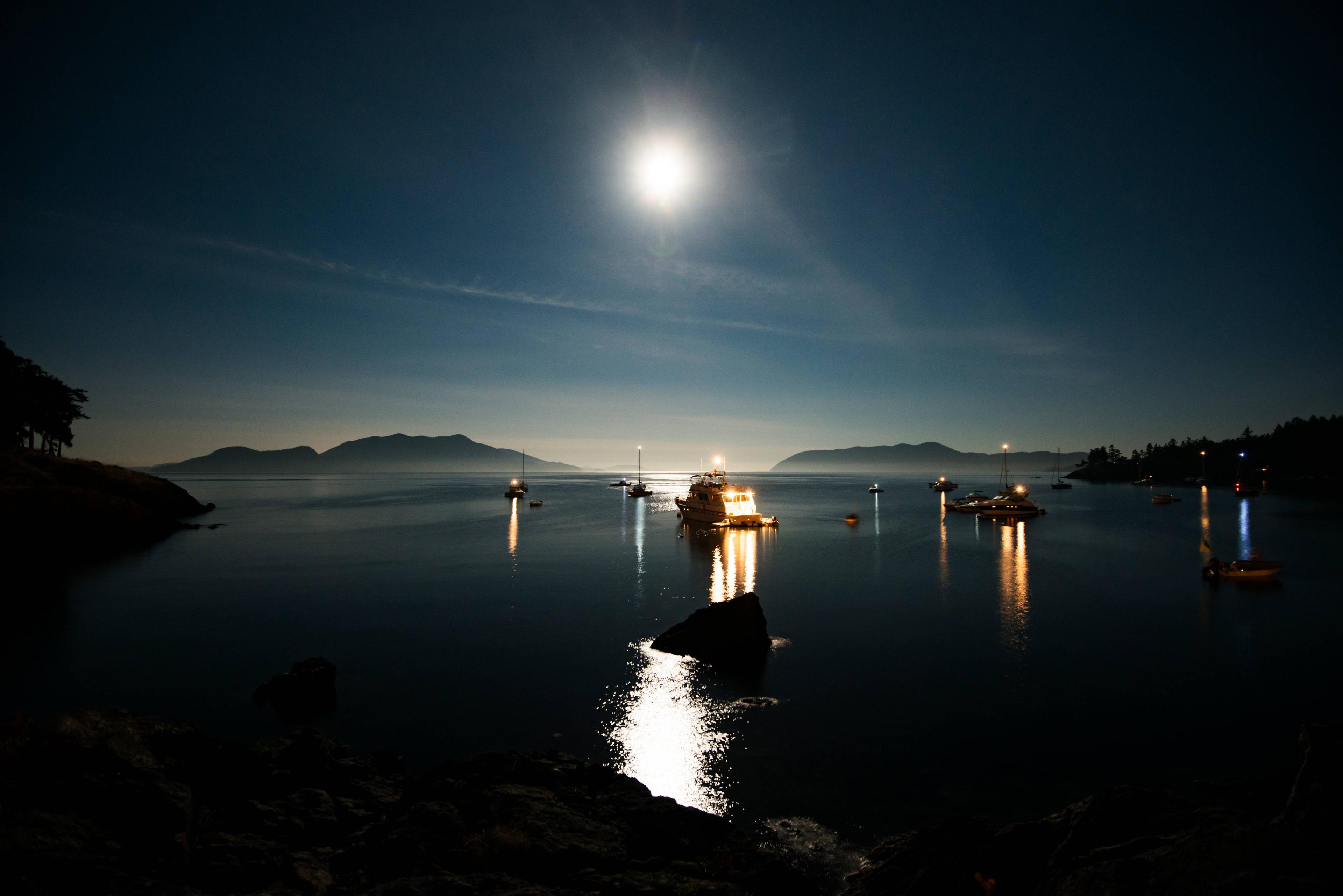
Boat navigation light types and functions

How Long does it Take to Sail Around the World
Oct 04, 2021
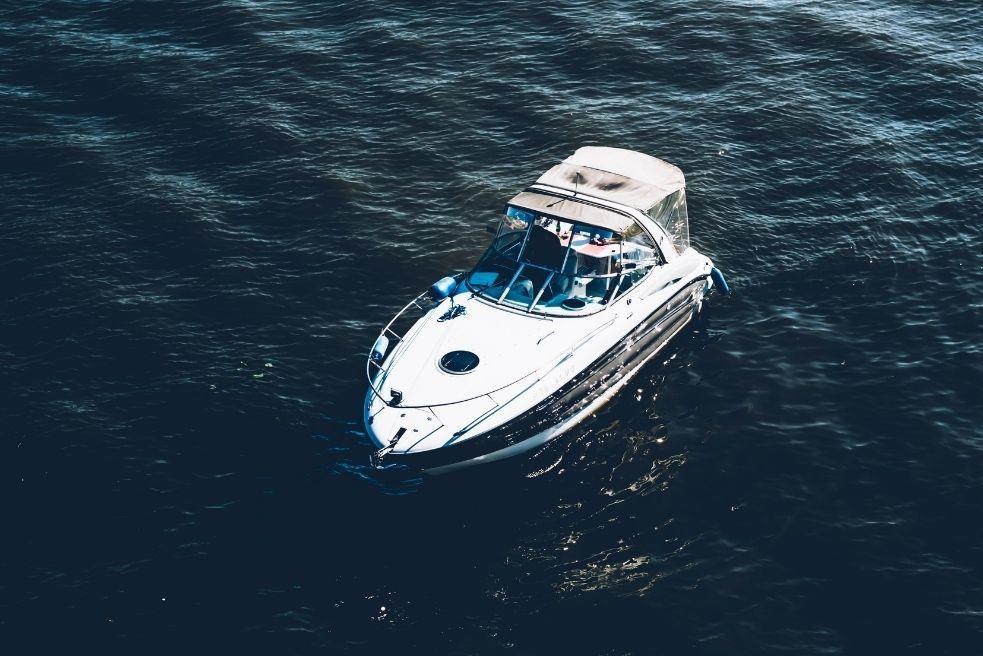
What are some Fun Things to Bring on a Boat
Oct 01, 2021
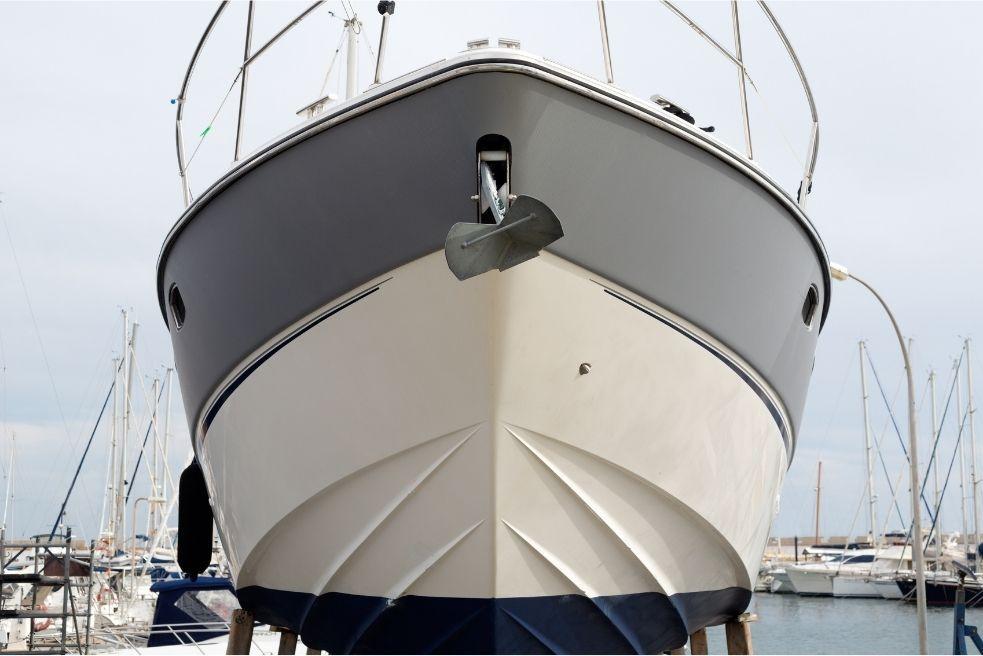
The Proper Term for the Forward End of a Boat
Sep 30, 2021
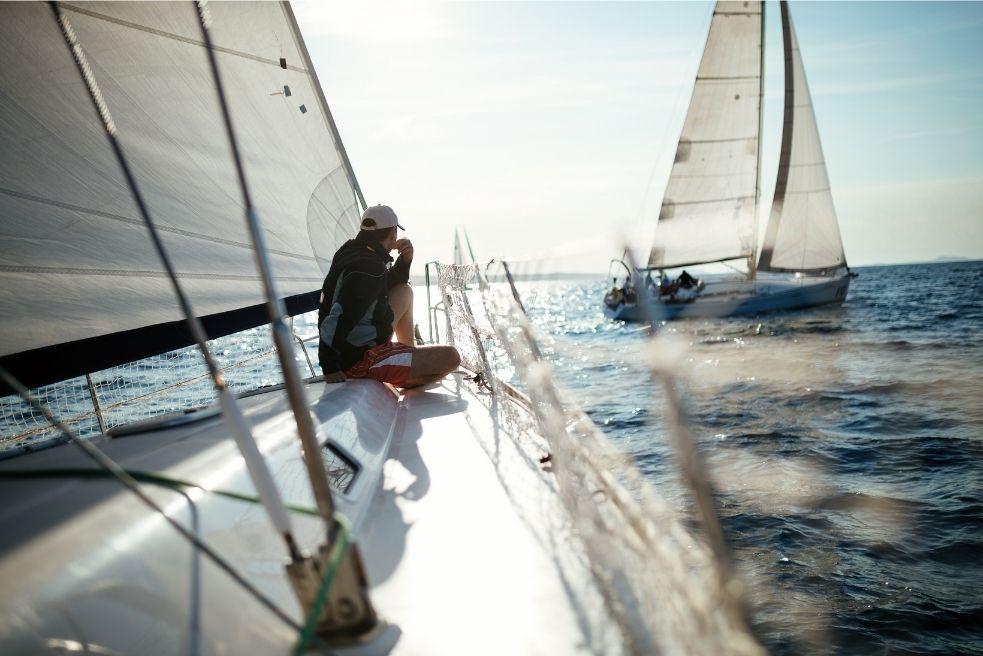
Regular Boat Maintenance Tasks You Should Always Do
Sep 17, 2021
How is Catamaran Sailing Different from Monohull Sailing?
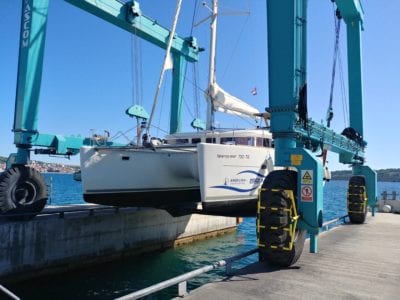
Sailing a catamaran is very similar to sailing a monohull in most aspects. If you learn to sail on a monohull, most of the skills are easily transferable. However, there are a couple of subtle differences that one has to be aware of:
- When tacking, you must work hard to maintain your speed throughout the tack and often need to ease your mainsheet to prevent “windvaning”. Windvaning is when the larger mainsail on a catamaran tries to turn the boat back into the wind.
- When gybing on a monohull, you must be very careful of an accidental gybe, and so you gybe much more slowly. On a catamaran, you can use the increased speed to your advantage and maintain speed while gybing to help depower the main.
- On a monohull, as winds increase, the boat starts heeling which lets you know that you have too much sail up and it’s time to reef. On a catamaran, because they do not heel, you have to be very careful in terms of when to reef the massive main. Typically, you will throw in the first reef at 18-20 knots of wind speed (depending on the size of your vessel) and put in a second reef as the wind gets closer to 23-25 kts)
Most aspects of sailing a catamaran are very similar to a monohull, so making the transition to a sailing catamaran is usually not that challenging of a process!
Why are Catamarans Popular?
Catamarans have exploded in popularity in the last 5 years! There are many advantages to catamarans over monohulls.
- Much more space on a catamaran!
- Catamarans are far more stable than monohulls so they do not heel when sailing, and are less prone to rocking when at anchor. Making for a much more comfortable boat!
- Catamarans have a shallow draft which allows them to enter shallower areas. In the South Pacific, most lagoons are 6-8 feet deep. This is too shallow for monohulls to enter, but a catamaran can easily enter these lagoons.
- Speed: Often, especially downwind, catamarans are faster than monohulls
- More light and airy living area. On a catamaran, the living space is usually up in the middle of the boat, built on the bridge deck whereas in a monohull you go down into the hull where it is darker and feels less open.
- More storage space and room for extra systems like air conditioning, water makers, generators, larger fridges and freezers, etc… Again, having room for all these amenities makes for more comfortable living.
What is a Catamaran?
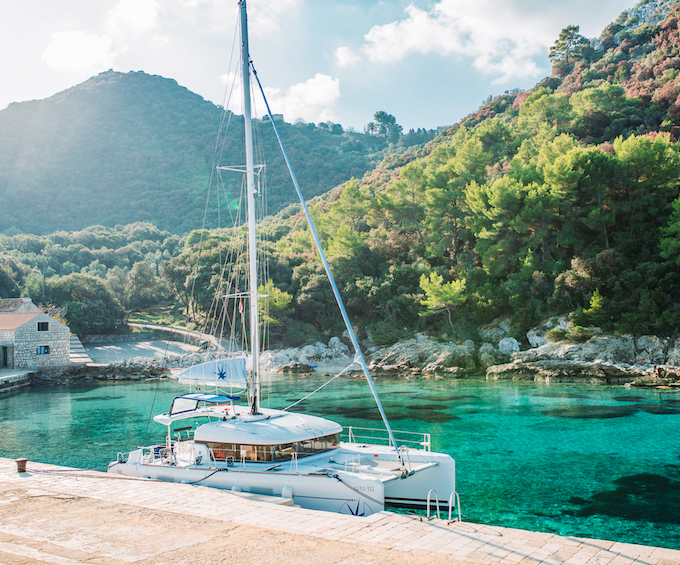
A catamaran is a sailboat with two hulls. These two hulls are connected by a bridge deck. Many people will be familiar with Hobie cats, small catamarans that are popular for sailing on lakes and in calmer waters. Cruising catamarans are based on this same principle but have large hulls that can fit many cabins inside, and house large structures on the bridge deck (like a galley, salon and living area).
Are catamarans safer than monohull sailboats?
Great question! Catamarans are much more stable than monohulls, and so people are less likely to fall overboard, which does make them safer in this aspect. They are larger, more stable boats, and so in most situations, this will make them a “safer” sailboat than a comparably sized monohull.
Catamarans also have the advantage of having 2 engines, which makes them “safer” when it comes to engine problems. On a monohull sailboat , if you have major engine problems you only have the option of sailing. On a catamaran, you always have a second motor ready to help out in an emergency!
Are catamarans easier to sail?
What makes monohulls harder to sail is heeling and more confined spaces. In stronger winds monohulls heel, making most tasks a little more difficult to manage. Whether you are going forward to reef, trying to winch in a sail or moving about the boat, sailing on a heeling boat is more challenging. Catamarans, however, because of their extra stability and room, allow for much easier movement around the boat as they do not heel. For this reason, catamarans are often considered “easier” to sail.
Can a catamaran cross the Atlantic?
Definitely! Early on many catamarans and trimarans were home-built from kits, and many of these boats gave catamarans a bad rap for offshore sailing. For decades now the major catamaran manufacturers have been improving these amazing vessels, and now catamarans are safe, stable and fast on offshore passages. In 2020 we completed an Atlantic crossing in our very own Never Say Never Lagoon 400S2 catamaran.
How fast does a catamaran sail?
Not all catamarans are created equal. Many of the production catamarans like Lagoon, Fountaine Pajot and Leopard are designed for cruising. This means that they are willing to sacrifice some performance in the interest of comfort for their owners and crew. These boats still are often faster than a monohull of comparable size when on a beam reach or downwind point of sail, often seeing speeds in the double digits. Upwind, catamarans do not usually have the same ability to point into the wind (as they have shorter, stubbier keels) and do not travel as quickly.
Some high-performance catamarans from manufacturers like Outremer, Gunboat and HH, make incredibly fast catamarans that can achieve speeds in the high teens and low 20s under ideal conditions.
Want to learn more?
Learning to sail a catamaran has it’s differences from monohulls. If you are planning on sailing catamarans, then it’s best to spend a week onboard one learning how to sail and operate these vessels. We offer catamaran sailing courses in the Grenadines (Caribbean), Sea of Cortez (Mexico), Mallorca (Spain) and Tahiti (South Pacific).
Our week-long live aboard courses truly are an incredible experience! You will spend the week learning over 100 different skills and learn to comfortably sail and operate the vessel. Upon successful completion of the course, you will earn ASA certification 101, 103, 104 and 114 (up to Cruising Catamaran certification) which allows you to charter catamarans internationally.
This intensive course will give you the knowledge, skills and experience to charter catamarans, or help you set sail on your vessel! All while having a blast, snorkelling, hiking and exploring exclusive bays.
- Next Post →
HOW IT WORKS
Connect With Us
Plan Your Trip
START YOUR SAILING JOURNEY NOW
As featured in.

EXCLUSIVE EVENTS
The only way to join our tribe is to learn to sail with Nautilus.
We’re really careful to make sure that we know and trust anyone coming on one of our special trips.
Join us on flotillas, offshore deliveries, free webinars and unforgettable sailing adventures around the world. Join the Tribe.
- TERMS OF USE
- Privacy Policy

What Are The Fastest Sailboats? (Complete List)

Whenever you are looking into buying a sailboat, they often tell you how fast it can go. So naturally, customers want to know, what are the fastest sailboats?
Depending on the model and brand of a sailboat, in addition to the right conditions out on the water, this answer can vary. But which sailboats are known to be the fastest?
Each style of sailboat has its advantages that make it fast. The V.O 60, X-Yachts X4.0, and Beneteau Oceanis 30.1 are great examples of fast monohull boats. For multihull boats, Rapido 60 (Trimaran), Dragonfly 40 (Trimaran), and ICE Cat 61 (Catamaran) are some of the fastest in that category.
The list can go on when you are talking about specialized performance boats, foiling boats, and even windsurfers. However, the most common sailboats that people can relate to are either monohulls or multihulls.
According to sailing experts, fast can mean 12 knots if you are only used to going about half that speed. But when you speak about the fastest sailboats, they usually top around 30 knots or more out on the water.
Table of contents
What Makes a Sailboat Fast?
A lot of variables come into play to help a sailboat reach its maximum potential for going fast. While the person running the boat is the one responsible for making it go fast, the weather conditions and type of boat have to be good in order to reach top speeds.
If a boat is not designed to handle rougher conditions, you will struggle with performance in those situations. If you have a boat that is built for anything nature throws at it, you might have better stability but considerably less speed even in good conditions.
Weight and Power of Boat
If you were to have two objects with different weights and put the same amount of force on them, the lighter object moves faster. This is why lighter boats move quicker than heavier boats.
So if you were to put two boats at one end of a race head to head with the same conditions of wind and sailing area, the lighter boat wins. This is because the lighter boat is able to gain speed quickly due to the less weight it holds.
The weight of the hull is only one part of the equation, as the mast can hold a lot of weight too. If there is a way to reduce the weight on the boat, you will have a better chance at going faster.
This is why fast boats typically are made out of materials such as carbon fiber or fiberglass. If the boat is a multi-hull without a keel, this also cuts down on weight.
Friction and Wetted Surface
Water adds a ton of friction to the boat, so a fast boat needs to be able to cut through it efficiently. In addition, some boats have finely polished exteriors to help glide through the water and reduce drag.
Depending on the shape of the hull and how much wetter surface it has can greatly affect the amount of drag it has. For example, displacement hulls change as the boat heels in the water.
For multihulls, these lift the hull out of the water slightly to reduce drag. Hydrofoils are another example that lifts the entire boat out of the water to greatly reduce the wetted surface.
Sail Area and Wind
The bigger the sails are on a boat does not necessarily mean the boat will be the fastest. While the sailing area is critical for speed, it has to match the sailing area to displacement ratio.
The sail area needs to be more about the lift of the sails rather than the size of them. If the proper sails are there, then the boat should be able to reach its maximum potential if the wind conditions are right.
Fastest Sailboat Types
The type of sailboat makes a big difference in speed since it has different characteristics. These include HP monohulls, catamarans, and trimarans.
Each boat type will have a unique position in the water, making it potentially faster than another type. If you want to compare boats in perfect conditions, you can see how one stacks up to another.
HP Monohulls
HP monohulls gain a lot of their speed by being powered by a motor. While they have the capability to sail using the wind, they have the convenience of a motor to help push them along.
So the outboard motor needs to be able to handle the weight of the boat efficiently in order to help reach top speeds. A lot of larger boats need to be pushed along by multiple motors.
Monohulls in general are favored by many sailors since they have that traditional look to them. They also happen to be very common, but multi-hulls are making things competitive in the market.
Catamarans do not have a keel and it helps reduce the weight of the boat. They also displace less water compared to a monohull. However, not all catamarans go fast.
Depending on the catamaran and its capabilities, there is some that glide effortlessly on the water. These ideally work best in good conditions but will be a bumpy ride if the water is a little choppy.
They offer one of the safest rides on the water and are essentially unsinkable due to their design. They spread out their weight over a larger area on the water, making them more stable than a monohull.
In addition, the living space on a monohull is huge compared to a monohull. With about a 40-foot catamaran, it has around the same living space as a 60-foot monohull.
Trimarans are another unique style of sailboat similar to a catamaran. They have three hulls side by side instead of two, making it very stable.
They also have a wide sail area and make for quick spurts out on the water. However, they also need good conditions to operate their best to move fast.
These displace water similar to a catamaran and are more stable. They also tend to go faster in the right conditions than a catamaran.
Both catamarans and trimarans generally have shallow drafts and can be beached. In coastal waters, monohulls have to watch out for their draft since they have a keel.
Fastest Monohull Sailboats
Some of the fastest monohull sailboats have unique characteristics that set it apart from other monohulls. These include sail area, weight, and wetted surface.
The beauty about monohulls is the keel, which has its advantages in tougher conditions. If you were to race a monohull against a multihull in moderate conditions, the monohull has a better chance at navigating through the water due to the keel and potentially going faster. The keel allows the boat to heel from one side to the other and come back to the center.
The Volvo Ocean 60 is one of the fastest monohull sailboats you can find. It is a perfect example of an offshore sailboat that is usually handled by four professional sailors and eight mates on deck.
This boat is roughly 64 feet long and sits about 12 feet in the water. The fastest that these boats go ranges around 35 to 40 knots, but it takes the right conditions and a little bit of patience for that large of a boat.
2. X-Yachts X4.0
The X4.0 yacht was a winner of the European Yacht of the Year award in 2020. It is a fairly new boat design, as it debuted in 2019.
This 40 foot luxury yacht is a top-of-the-line performance cruiser that is built for speed and is lightweight. Sitting about eight feet in the water, this boat can reach up to 10 knots or potentially more with the right conditions. You can quickly reach these speeds due to its size and weight.
3. Beneteau Oceanis 30.1
The Beneteau Oceanis 30.1 is another great example of a power cruising yacht that is new to the scene in 2019. At around 31 feet, it is one of the smaller yachts on the list but packs a powerful punch in performance and speed.
The max draft of this one is just shy of 6.5 feet and it received the Best Performance Cruiser in 2020. While this one, in particular, is built more for luxury and comfort, you can easily see top speeds ranging from 7.5 to 10 knots.

4. Santa Cruz 52
The Santa Cruz 52 is a perfect combination of a lightweight sloop and a blue water racer. At 53 feet long and a draft of nine feet, this boat is a beauty to see go fast.
These are often compared to the original Swan sailboats around the same length, as far as the class and style of the boat. In good conditions, they top around eight knots on a good day.
The Amel 60 is another beauty of a luxury yacht cruiser spanning almost 60 feet in length and nearly an eight-foot draft. This boat began production in 2019 and received the 2020 European Yacht of the Year Luxury Cruiser award.
With a reliance on the engine, you can push the boat a little harder in good conditions to gain more speed. While topping out the engine, you are looking at anywhere between eight and 10 knots.
Fastest Multihull Sailboats
Multihull sailboats are generally faster than monohull sailboats due to their lack of extra weight. These are up to 30 percent faster in that situation.
The only downside is that if you want to reach those maximum speeds, you cannot add a lot of extra weight to the vessel. So for sailors that want to utilize a multihull’s full potential, they need to consider what they bring on board and how many people they have.
1. Rapido 60 (Trimaran)
The Rapido 60 is one of the fastest multihulls out there for its size. At nearly 60 feet in length and almost 11 feet in draft, this unsinkable trimaran can speed up to 25 knots.
These were first built in 2015 and are a popular trimaran to look at if you are wanting the space. In the right conditions, the manufacturer says you can easily reach 30 knots if not more.
2. Dragonfly 40 (Trimaran)
The Dragonfly 40 is one of the few 40-footers out there that you can operate shorthanded. While it typically accommodates six to eight people, the boat’s design allows it to be easily handled.
According to the manufacturer, they claim it can reach 24 knots. Assuming the conditions are perfect, it could potentially reach more.
3. ICE Cat 61 (Catamaran)
The ICE Cat 61 is just a tad over 61 feet long and is one of the more beautiful catamarans you will ever see. For its size and design, it is impressive to see it reach top speeds.
With just the motors alone, you can easily reach 13.5 knots. If all the right conditions are in play, you can expect to reach up to 25 knots.
4. SIG45 (Catamaran)
The SIG 45 is a 45-foot racing cruiser that can comfortably hold about six people. With features like low dragging bows, carbon fiber material found in spars and bulkheads, and around 1,400 square feet of sailing area to play with, you can expect top performance all the way around.
It is estimated that this boat can safely top out around 20 knots. However, there is room for more knots in the best conditions.
5. Lagoon 67 S (Catamaran)
The Lagoon 67S is one of the rarest catamarans you will ever see. There were only four built from 1993 to 1995 by Jeanneau Technologies Avancées and are a gorgeous sight to see.
Regardless of the age of this boat, it still flies in the right conditions like the newer catamarans you see today. You can expect to reach a little over 20 knots for this 67 footer and about five feet of draft.
Related Articles
Daniel Wade
I've personally had thousands of questions about sailing and sailboats over the years. As I learn and experience sailing, and the community, I share the answers that work and make sense to me, here on Life of Sailing.
by this author
Best Sailboats
Learn About Sailboats
Most Recent

Affordable Sailboats You Can Build at Home
September 13, 2023

Best Small Sailboat Ornaments
September 12, 2023
Important Legal Info
Lifeofsailing.com is a participant in the Amazon Services LLC Associates Program, an affiliate advertising program designed to provide a means for sites to earn advertising fees by advertising and linking to Amazon. This site also participates in other affiliate programs and is compensated for referring traffic and business to these companies.
Similar Posts

Best Small Sailboats With Standing Headroom
December 28, 2023

Discover the Magic of Hydrofoil Sailboats
December 11, 2023

Best Bluewater Sailboats Under $50K
Popular posts.

Best Liveaboard Catamaran Sailboats

Can a Novice Sail Around the World?
Elizabeth O'Malley
June 15, 2022

4 Best Electric Outboard Motors

How Long Did It Take The Vikings To Sail To England?

10 Best Sailboat Brands (And Why)
December 20, 2023

7 Best Places To Liveaboard A Sailboat
Get the best sailing content.
Top Rated Posts
© 2024 Life of Sailing Email: [email protected] Address: 11816 Inwood Rd #3024 Dallas, TX 75244 Disclaimer Privacy Policy
How SailGP’s foiling F50 catamarans sail so much faster than the wind

Arguably the most technologically advanced sailboats on the planet right now, the one-design SailGP F50 foiling catamarans are capable of breathtaking speeds – at times, reaching four times the velocity of the wind that drives them. But how do they do it?
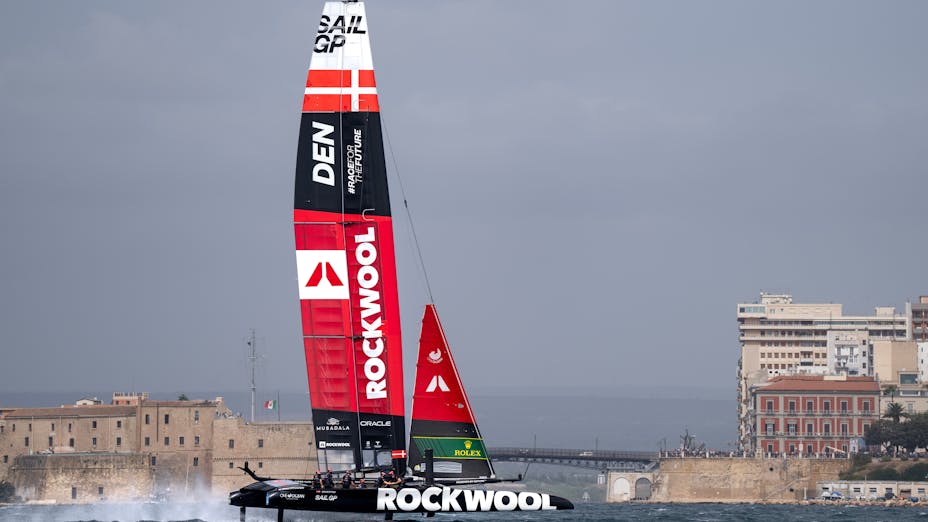
Beating the balloon

Bending the laws of physics

Faster and faster

Beneath The Surface
Watch on youtube.
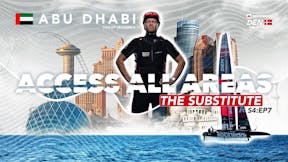
Access All Areas
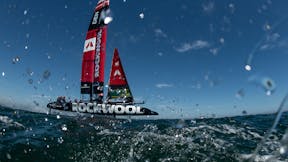
Want to learn more about SailGP?
Meet the denmark sailgp team, find all the latest news, go beneath the surface of sailgp, sailing terms, go beneath the surface.
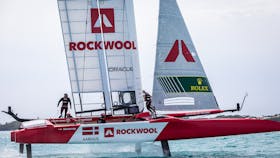
How the world’s fastest sail racing boats fly above the water
Tune in to SailGP’s landmark Season 2 opener in Bermuda at the end of the month, and you’d be forgiven for thinking that your eyes are deceiving you.

The Beneath The Surface show
We go Beneath The Surface of SailGP's iconic host cities, set a spotlight on great projects and curious mind and catch all the lastest with the Denmark SailGP Team. Join us as we travel the world and explore how innovation and science is helping solve the world's biggest challenges!
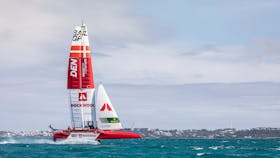
This is how SailGP's NASA-inspired wings make the F50 boats fly
Some may say the foils, which help the boats to fly above the water. Others may claim it’s the platform – that’s the two, catamaran hulls and the trampoline that connects them.

ROCKWOOL Denmark SailGP Team
The official home of the ROCKWOOL Denmark SailGP Team. Meet the team, read all the latest stories and explore a world of exciting content.

ROCKWOOL Group

How Fast Can a Catamaran Sail?

What is a catamaran? This question is asked by many people, especially those who have never seen this type of boat before. A catamaran is a type of sailboat that has a few key differences from regular sailboats and boats. In this blog post, we will discuss the basics of catamarans and how they compare to both each other and other boats.
What is a catamaran and how does it sail?
A catamaran is a type of sailboat that is characterized by having two hulls, or pontoons, attached to one another. Catamarans are often used for pleasure cruising and racing and are able to reach high speeds due to their design.
It is powered by sails and is mainly used for recreation. Catamarans are stable and can sail in shallow waters. They are also faster than monohull vessels because they have less drag. The speed of a catamaran heavily depends on the wind conditions and the size of the vessel.
How fast can a catamaran sail and what are the speeds for different types of catamarans?
As we said earlier, the speed of a catamaran depends on the wind conditions and the size of the boat. Most catamarans can sail at speeds between 15 and 30 knots. Some racing catamarans can reach speeds of up to 30 knots. Of course, there are always exceptions to the rule and some catamarans can sail faster or slower depending on the conditions.
However, the average cruising speed for a catamaran is around 12 knots. This means that it would take approximately five hours to travel 60 nautical miles.
Factors that affect a catamaran’s speed
There are a few factors that can affect the speed of a catamaran. The first is the wind. If the wind is blowing against the boat, it will slow it down. The second factor is the size of the boat. A larger catamaran will usually be slower than a smaller one. The third factor is the type of sails that are being used. Some sails are designed to go faster in certain conditions than others.
There are a variety of types of catamarans, such as ultralight, cruisers, and sport catamarans which all have different amenities. Catamarans as a whole are built to pierce through waves making them a fantastic boat for ocean waters. Depending on what type of catamaran you’re in, there will be a difference in the performance of each.
The best wind conditions for sailing a catamaran
The best wind conditions for sailing a catamaran are when the wind is blowing from behind the boat. This is because the sails will be able to catch more wind and the boat will be pushed forward. When the wind is blowing from the side, it can create drag and slow the boat down. If the wind is too strong, it can also cause the boat to tip over.
The best way to sail in different types of winds is to adjust the sails accordingly. For example, if it is windy, you would want to reef, or lower, the sails so that they are not catching as much wind.
Fun Activities for Catamaran Rides
A catamaran is a great way to get out and explore when you’re near the beach. Whether you have a friend with a boat or want to take a tour, it’s guaranteed to be a fun and unique experience.
If you ever find yourself on the Big Island of Hawaii, there are a variety of businesses that can take you out on a catamaran for different fun activities. We at Kona Style offer a variety of exciting outdoor activities, such as a manta ray night snorkeling trip , or a simple afternoon snorkel and sail along the Hawaiian coast. You have a bunch of different snorkeling tour options when you book with Kona Style.
Whatever you’re looking for, someone on the island can offer it. Make sure to do your research and figure out what catamaran sailing adventure is best for you.
Time to Sail
Now that you know what a catamaran is and what they can do out in the water – you can start planning your sailing adventure. These versatile boats can accommodate pretty much any activity you have planned for the water – from a relaxing cruise in the sunset to snorkeling late at night with the manta rays.
We at Kona Style offer a variety of ways to get out and experience the power of catamaran and explore the Hawaiian waters. Call us now at (808) 936-1323 or email us at [email protected] with any questions you may have about your vacation. We hope you’ve enjoyed this blog post.

KEALAKEKUA SNORKEL & SAIL

SUNSET & MANTA RAY SNORKEL

AFTERNOON MARINE ADVENTURE
Visit our Popular Forums
- Monohull Sailboats
- Multihull Sailboats
- Powered Boats
- General Sailing
- Antares Yachts
- Fountaine Pajot
- Lagoon Catamarans
Cruising Business
- Boat Classifieds
- General Classifieds
- Crew Positions
- Commercial Posts
- Vendor Spotlight
Life Aboard a Boat
- Provisioning: Food & Drink
- Families, Kids, & Pets Afloat
- Recreation, Entertainment, & Fun
- Boat Ownership & Making a Living
- Liveaboard's Forum
Seamanship, Navigation & Boat Handling
- Seamanship & Boat Handling
- Training, Licensing, & Certification
- Health, Safety, & Related Gear
- Rules of the Road, Regulations, & Red Tape
Engineering & Systems
- Const. / Maint. / Refit
- Product / Service Reviews
- Electronics: Comms / AV
- Electrical: Batts / Gen / Solar
- Lithium Power Systems
- Engines & Propulsion
- Propellers & Drive Systems
- Plumbing / Fixtures
- Deck Hdw: Rigging / Sails
- Aux. Equipment & Dinghy
- Anchoring & Mooring
Photo Categories
- Member Galleries
- Life Onboard
- Sailing in the Wind
- Power Boats
- Cruising Destinations
- Maint. & Boat Building
- Marine Life
- Scuba Diving & Divers
- General Photos
Recent Photos

Listing Categories
- African Cats
- view more »
- Crew Wanted
- Crew Available
- Enhance Your Account
- Meet the Mods
- Meet the Advisors
- Signup for The Daily Cruiser Email







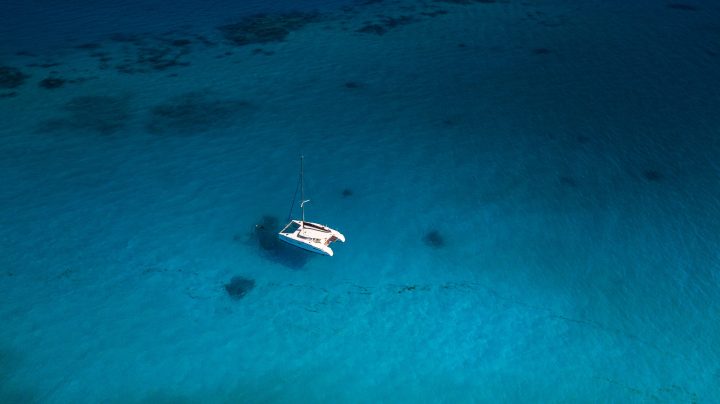
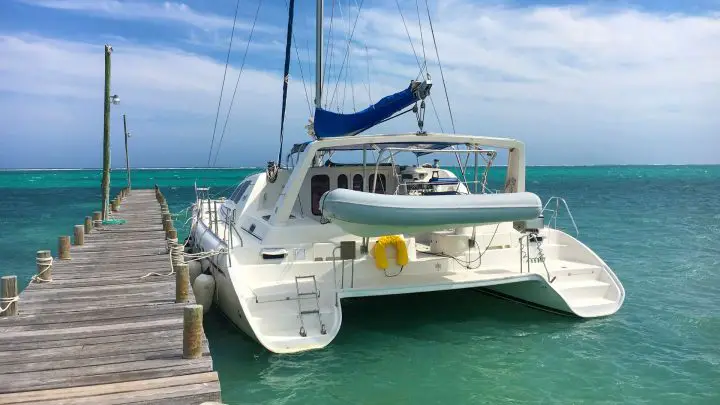

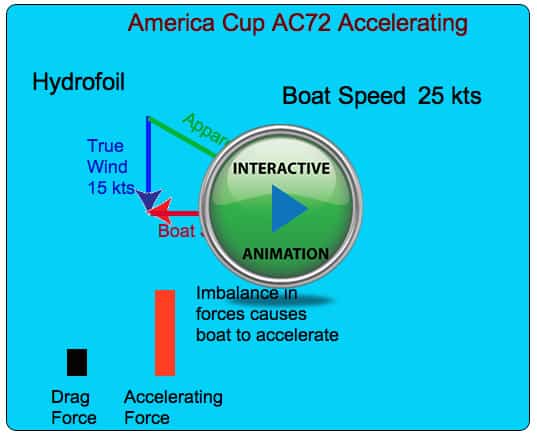



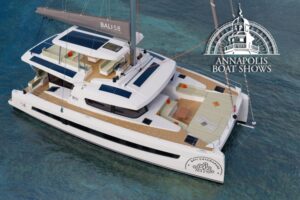




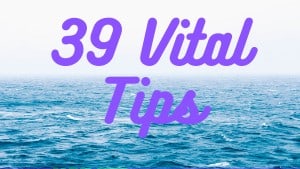

IMAGES
VIDEO
COMMENTS
Daniel Wade. Catamarans are known for their speed, and some vessels are fast enough to break world sailing speed records. Catamarans can go between 15 and 30 knots, with the fastest achieving speeds well in excess of 60 knots. Sailing catamarans are sometimes twice as fast as monohulls and cut through the water with greater efficiency.
Sailing catamarans typically average about 10 knots. Pontoon boats average about 20 mph. A powerboat cruiser can average anywhere between 30 and 50 mph. Cigarette boats can even reach close to 90 mph in the proper conditions. Sailboats average between 6 and 12 mph depending on wind conditions.
Still, cruising catamarans can be great racing boats, but just how fast can they go? Some of the fastest cruising catamarans include the Gunboat 68 (35 knots), Outremer 45 (25 knots), ORC50 (25 knots), FastCat 435 (20 knots), TS 42 (35 knots), and Lagoon 440 (20 knots). Yet, there are many more cats that can reach 35 knots safely.
Sailing catamarans typically average about 10 knots while pontoon boats average about 16 knots. As for powerboats, they can average anywhere between 30 and 50 mph. Most average sailboats are designed with monohulls and they average from 6 to 9 knots depending on wind conditions.
So, how fast are cruising catamarans? Sailing cruising catamarans can travel at an average of 9-15 knots and max out around 35 kts. Power Cruising catamarans have a maximum speed of 70 knots but averages around 20-25 kts. How fast a catamaran can go also depends on the load it is carrying, its structural design, and its engine power.
Factors Affecting Catamaran Speed: There are several factors that determine how fast a sail catamaran can go. Let's take a closer look at them: 1. Hull Design: The design of the hull plays a significant role in determining the speed of a catamaran. Catamarans typically have two parallel hulls connected by a deck structure, which reduces drag ...
Short Answer. The speed of a catamaran depends on the type and size of the boat, as well as the weather and water conditions. Generally, a catamaran can travel at speeds of between 6-8 knots (7-9 mph) when under power, and as much as 20 knots (23 mph) under sail.
How fast can catamarans go? The speed a catamaran can go is entirely dependent upon the hull design, weight of the vessel, the strength of propulsion (be it wind or powered) and so on. The general rule is that in terms of sailing cats vs monohull sailboats, a cat of equal length can typically go faster than a sailboat.
Catamarans can be much faster than monohulls. This comes as a result of two hulls that are narrower than just one and allow the boat to cut through the waves by reducing drag and causing planing. Planing is the lifting of a boat over the water, a process that makes them go much faster. Normally, a catamaran's top speed is between 15 and 30 ...
Sailing catamarans come in all different shapes and sizes. Some are optimized for living space and comfort, while others are designed with fast cruising speeds being the sole goal of the boat. The Gunboat 68, one of the fastest cruising sailboats currently made, can exceed 30 knots.
An F50 catamaran preparing for the Sail GP series recently even broke this barrier, reaching an incredible speed of 50.22 knots (57.8mph) purely powered by the wind. This was achieved in a wind of ...
A sport cruising catamaran can reach 30 knots. A racing catamaran is somewhat faster and can sail at 45 knots. The power cruising catamaran is probably the fastest vessel and can travel at 70 knots. One of the main features that make catamarans so fast is the integration of assisting foils that lift the boat off the water.
This is the formula for Maximum Hull Speed on a displacement boat: Max hull speed= √((Length on Water Line x g) /(2 x pi)) x 3600/1852. Now we need to add the increased efficiency (loss of drag) of a semi-displacement hull, usually, this is somewhere between a 10-30% increase. Semi Displacement hull speed = Maximum hull speed * 1.3.
A catamaran is a sailboat with two hulls. These two hulls are connected by a bridge deck. Many people will be familiar with Hobie cats, small catamarans that are popular for sailing on lakes and in calmer waters. Cruising catamarans are based on this same principle but have large hulls that can fit many cabins inside, and house large structures ...
The goal is speed, performance and offshore comfort, both in the strong stuff and, more importantly, in whispering airs that park-up monohulls. "A good performance catamaran can sail 1.2 to 1.5 times faster than windspeed in some conditions, meaning less time motoring and more time sailing," says Greg Young, designer of the TAG 60.
The V.O 60, X-Yachts X4.0, and Beneteau Oceanis 30.1 are great examples of fast monohull boats. For multihull boats, Rapido 60 (Trimaran), Dragonfly 40 (Trimaran), and ICE Cat 61 (Catamaran) are some of the fastest in that category. The list can go on when you are talking about specialized performance boats, foiling boats, and even windsurfers.
How SailGP's foiling F50 catamarans sail so much faster than the wind. Jonathan Turner. January 8, 2023. Arguably the most technologically advanced sailboats on the planet right now, the one-design SailGP F50 foiling catamarans are capable of breathtaking speeds - at times, reaching four times the velocity of the wind that drives them.
Most catamarans can sail at speeds between 15 and 30 knots. Some racing catamarans can reach speeds of up to 30 knots. Of course, there are always exceptions to the rule and some catamarans can sail faster or slower depending on the conditions. However, the average cruising speed for a catamaran is around 12 knots.
The two are very different and you can't make a power cat shape work well when sailing in lighter winds and upwind and you can't make a sailing shape work well at high speeds under power. Just chill out and go at 7 knots. Even though our boat has hit 19.9 knots, we average about 7.5 to 8.5 most of the time. You don't go that fast.
Short Answer. Sailing a catamaran is relatively straightforward. To get started, adjust the sails and rudder to the desired angles. Next, begin to move forward using the power of the wind and the force of the sails. While underway, make sure to constantly adjust the sails and rudder to maintain the desired course.
The crew wrote a detailed report of the experience and the boat's performance. CONDOR exceeded 30 knots occasionally, but average speeds were between 14 and 17 knots. Their best 24 hours saw 328 nm (an average speed of 13.7 knots). The company motto says it all. "Life is too short to sail a slow boat.".
We have fielded many questions about how these catamarans can sail so fast. One of the best explanations of what happens when these catamarans get going, is the one by Grant from NauticEd. He explains how these AC72 not only goes faster than the true wind, but actually go faster than the apparent wind. He points out that the limitation on boat ...
Sailing single-handed. Catamarans, when set up correctly, can be sailed single-handed or shorthanded. Some of the changes you'll have to make include; Get an autopilot; Make sure your lines go all the way to the cockpit, so you don't have to leave your GPS, radar, etc. Remove things that are obstructing your view; there are only two eyes on ...